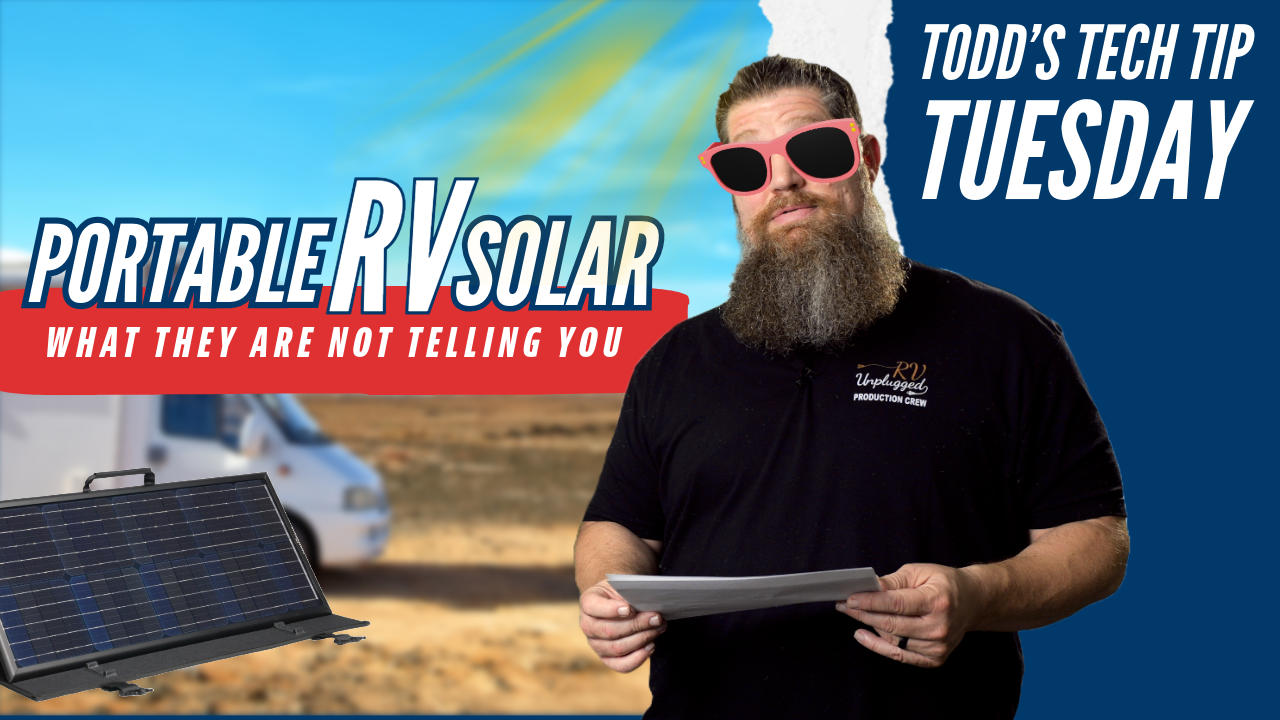Get your RV Technician Certification in as little as 5 weeks!

Welcome back to another episode of Todd’s Two-Minute Tech Tip Tuesday, brought to you by the National RV Training Academy—the largest hands-on RV training academy in America. Before we dive into today’s tips, make sure to hit the Subscribe button so you never miss an update. Now, let’s get back to our Tech Tip Tuesday!
This week, we’re addressing two solar-related questions—perfect timing given how hot it is. Let’s dive in.
Connecting Additional Solar Panels to Your RV
Question 1: Using the Side Port Solar Hookup
A viewer with the handle “It’s Just That Easy” asked about their 2022 Winnebago Flex, which has two 190-watt roof panels connected to a 30-amp Go Power solar controller. They want to add a 100-watt panel via the side port but have received mixed replies about whether this will work or if it will degrade the system.
Understanding Solar Controller Functionality
- Role of the Solar Controller: Similar to a converter, it takes varying input voltages from the solar panels (ranging from 16 to 100 volts) and converts them to a usable 12 volts DC to charge the RV’s batteries.
- Importance of Matching Panels: It’s crucial to match the voltage of all panels connected to the same controller. Mismatched voltages can cause inefficiencies and reduce the overall performance of the system.
Potential Issues with the Side Port Hookup
- Voltage Compatibility: The existing roof panels likely operate around 20.4 volts, while the 100-watt panel may operate at 16 or 17 volts. If connected in parallel without matching voltages, the system can become unstable, leading to inefficiencies.
- Degradation Risk: Connecting a lower voltage panel can degrade the system’s performance, causing the controller to jump between voltages and reduce charging efficiency.
Recommended Solutions
- Separate Solar Controller: For about $30-$40, you can get an individual solar controller for the 100-watt panel.
- Match the Panels: Instead of adding a 100-watt panel, consider adding another 190-watt panel to match the existing setup.
Practical Steps
- Check Connections: Verify if the side port is connected to the solar controller or directly to the battery. If it’s directly connected to the battery without a controller, do not use it.
- Manufacturer Support: Contact the manufacturer for specific details about your RV’s solar wiring and setup.
By following these guidelines, you can ensure your solar system operates efficiently without risking damage or reduced performance.
Managing Parasitic Draw in Your RV
Question 2: Impact of Leaving Charging Cords Plugged In
Susan Ryan asked about parasitic draw in her RV. She has six 200-watt panels, a 2,000-watt inverter, and two 200 amp-hour lithium batteries. Susan wants to know if leaving charging cords plugged into USB or regular outlets without a device attached draws power.
Understanding Parasitic Draw
- Parasitic Draw: The small, continuous power consumption from devices or systems that remain powered even when not in active use.
- Typical Draw: Even with everything turned off, expect a parasitic draw of around 1 amp due to various circuit boards and essential systems like the CO detector.
Impact of Charging Cords
- Negligible Draw: Leaving charging cords plugged in without a device typically results in minimal power draw.
- Inverter Draw: The 2,000-watt inverter itself draws around 25 to 40 watts per hour just by being ready to invert power.
Practical Advice
- Battery Capacity: With two 200 amp-hour batteries, you have a substantial capacity (400 amp-hours). A minor parasitic draw is generally not significant enough to warrant constant unplugging of devices.
- Extended Off-Grid Use: If you plan extended off-grid stays, monitor and manage power usage more closely to ensure battery longevity.
Testing for Parasitic Draw
- Perform an Amp Draw Test: Turn everything off in your RV and measure the amp draw on the positive or negative battery cable. Expect around 1 amp of parasitic draw.
By understanding and managing parasitic draw, you can maintain your RV’s battery health without the hassle of constantly plugging and unplugging devices.
Final Thoughts
Both questions highlight the importance of understanding your RV’s electrical system and managing power efficiently. Whether you’re connecting additional solar panels or dealing with parasitic draw, making informed decisions ensures a smoother and safer RV experience.
If you have more questions or need further advice, drop them in the comments below. And if you haven’t subscribed yet, what are you waiting for? Hit the Subscribe button, smash the bell icon, and stay tuned for more tips. Have a wonderful day!
Stay safe, enjoy your RV adventures, and see you next Tuesday for another tech tip!
4o
Get Registered Today!
Talk to a student advisor to learn more!